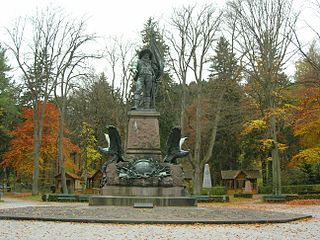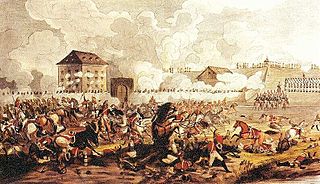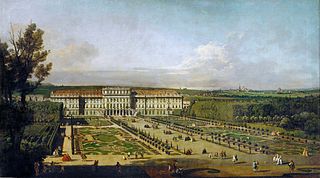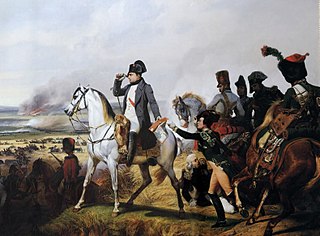 W
WIn the Battle of Aspern-Essling, Napoleon attempted a forced crossing of the Danube near Vienna, but the French and their allies were driven back by the Austrians under Archduke Charles. The battle was the first time Napoleon had been personally defeated in over a decade, but Aspern would be a sign of numerous military defeats and blunders that would soon hinder Napoleon. However, Archduke Charles failed to secure a decisive victory as Napoleon was able to successfully withdraw most of his forces.
 W
WThe Battle of the Basque Roads, also known as the Battle of Aix Roads, was a major naval battle of the Napoleonic Wars, fought in the narrow Basque Roads at the mouth of the Charente River on the Biscay coast of France. The battle, which lasted from 11–24 April 1809, was unusual in that it pitted a hastily-assembled squadron of small and unorthodox British Royal Navy warships against the main strength of the French Atlantic Fleet, the circumstances dictated by the cramped, shallow coastal waters in which the battle was fought. The battle is also notorious for its controversial political aftermath in both Britain and France.
 W
WThe Battles of Bergisel were four battles fought between the forces of Emperor Napoleon I of France and the Kingdom of Bavaria against Tyrolese militiamen and a contingent of Austrian regular soldiers at the Bergisel hill near Innsbruck. The battles, which occurred on 25 May, 29 May, 13 August, and 1 November 1809, were part of the Tyrolean Rebellion and the War of the Fifth Coalition.
 W
WA Franco-Persian alliance or Franco-Iranian alliance was formed for a short period between the French Empire of Napoleon I and Fath Ali Shah against Russia and Great Britain between 1807 and 1809. The alliance was part of a plan to gather extra aid against Russia and by Persia's help, having another front on Russia's southern borders, namely the Caucasus region. The alliance unravelled when France finally allied with Russia and turned its focus to European campaigns.
 W
WThe Battle of Graz took place on 24–26 June 1809 between an Austrian corps commanded by Ignaz Gyulai and a French division led by Jean-Baptiste Broussier. The French were soon reinforced by a corps under Auguste Marmont. The battle is considered a French victory though Gyulai was successful in getting supplies to the Austrian garrison of Graz before the two French forces drove him away from the city. Graz, Austria is located 145 kilometers south-southwest of Vienna at the intersection of the modern A2 and A9 highways.
 W
WThe Battle of Piave River was fought on 8 May 1809 between the Franco-Italian army under the command of Eugène de Beauharnais and an Austrian army led by Archduke John of Austria. The Austrian commander made a stand behind the Piave River but he suffered a defeat at the hands of his numerically superior foes. The combat took place near Nervesa della Battaglia, Italy during the War of the Fifth Coalition, part of the Napoleonic Wars.
 W
WThe Battle of Raab or Battle of Győr was fought on 14 June 1809 during the Napoleonic Wars, between Franco-Italian forces and Habsburg forces. The battle was fought near Győr (Raab), Kingdom of Hungary, and ended in a Franco-Italian victory. The victory prevented Archduke John of Austria from bringing any significant force to the Battle of Wagram, while Prince Eugène de Beauharnais's force was able to link up with Emperor Napoleon at Vienna in time to fight at Wagram. Napoleon referred to the battle as "a granddaughter of Marengo and Friedland", as it fell on the anniversary of those two battles.
 W
WThe Battle of Ratisbon, also called the Battle of Regensburg, was fought on 23 April 1809, during the Napoleonic Wars, between the army of the First French Empire, led by Napoleon I, and that of the Austrian Empire, led by Archduke Charles. Scene of the last engagement of the Bavaria phase of the campaign of 1809, the brief defense of the city and installation of a pontoon bridge to the east enabled the retreating Austrian army to escape into Bohemia. During the assault, Marshal Jean Lannes led his troops up ladders onto the walls, and Napoleon was wounded in his ankle by a small artillery round. The shot had been fired at great distance and did not severely hurt the Emperor, but caused a contusion.
 W
WThe Battle of Les Sables-d'Olonne was a minor naval battle fought on 23 February 1809 off the town of Les Sables-d'Olonne on the Biscay Coast of France between a French Navy squadron of three frigates and a larger British squadron of ships of the line. The French squadron had sailed from the port of Lorient on 23 February in an effort to link up with a fleet from Brest under Jean-Baptiste Willaumez, but missed the rendezvous and was pursued by a British blockade squadron under Rear-Admiral Robert Stopford. The French commander, Commodore Pierre Roch Jurien, anchored his squadron under the batteries which protected the town of Les Sables-d'Olonne in the hope of dissuading an attack.
 W
WThe Battle of Sacile on 16 April 1809 and its companion Clash at Pordenone on 15 April saw an Austrian army commanded by Archduke John of Austria defeat a Franco-Italian army led by Eugène de Beauharnais and force it to retreat. Sacile proved to be the most notable victory of John's career. The action took place east of the Livenza River near Sacile in modern-day Italy during the War of the Fifth Coalition, part of the Napoleonic Wars.
 W
WThe Battle of Tarvis from 16 to 17 May 1809, the Storming of the Malborghetto Blockhouse from 15 to 17 May 1809, and the Storming of the Predil Blockhouse from 15 to 18 May saw the Franco-Italian army of Eugène de Beauharnais attacking Austrian Empire forces under Albert Gyulai. Eugène crushed Gyulai's division in a pitched battle near Tarvisio, then an Austrian town known as Tarvis. At nearby Malborghetto Valbruna and Predil Pass, small garrisons of Grenz infantry heroically defended two forts before being overwhelmed by sheer numbers. The Franco-Italian capture of the key mountain passes allowed their forces to invade Austrian Kärnten during the War of the Fifth Coalition. Tarvisio is located in far northeast Italy, near the borders of both Austria and Slovenia.
 W
WThe Battle of Teugen-Hausen or the Battle of Thann was an engagement that occurred during the War of the Fifth Coalition, part of the Napoleonic Wars. The battle was fought on 19 April 1809 between the French III Corps led by Marshal Louis-Nicolas Davout and the Austrian III Armeekorps commanded by Prince Friedrich Franz Xaver of Hohenzollern-Hechingen. The French won a hard-fought victory over their opponents when the Austrians withdrew that evening. The site of the battle is a wooded height approximately halfway between the villages of Teugn and Hausen in Lower Bavaria, part of modern-day Germany.
 W
WThe Treaty of Schönbrunn, sometimes known as the Peace of Schönbrunn or Treaty of Vienna, was signed between France and Austria at Schönbrunn Palace near Vienna on 14 October 1809. The treaty ended the Fifth Coalition during the Napoleonic Wars, after Austria had been defeated at the decisive Battle of Wagram on 5-6 July.
 W
WThe Battle of Wagram was a military engagement of the Napoleonic Wars that ended in a costly but decisive victory for Emperor Napoleon Bonaparte's French and allied army against the Austrian army under the command of Archduke Charles of Austria-Teschen. The battle led to the breakup of the Fifth Coalition, the Austrian and British-led alliance against France.
 W
WThe Walcheren Campaign was an unsuccessful British expedition to the Netherlands in 1809 intended to open another front in the Austrian Empire's struggle with France during the War of the Fifth Coalition. Sir John Pitt, 2nd Earl of Chatham, was the commander of the expedition. with the missions of capturing Flushing and Antwerp in the Netherlands and enabling navigation of the Scheldt River. Some 40,000 soldiers, 15,000 horses together with field artillery and two siege trains crossed the North Sea and landed at Walcheren on 30 July. This was the largest British expedition of that year, larger than the army serving in the Peninsular War in Portugal. Nevertheless it failed to achieve any of its goals. The Walcheren Campaign involved little fighting, but heavy losses from the sickness popularly dubbed "Walcheren Fever". Although more than 4,000 British troops died during the expedition, only 106 died in combat; the survivors withdrew on 9 December.
 W
WIn the Battle of Wörgl or Wörgel on 13 May 1809 a Bavarian force under French Marshal François Joseph Lefebvre attacked an Austrian Empire detachment commanded by Johann Gabriel Chasteler de Courcelles. The Bavarians severely defeated Chasteler's soldiers in series of actions in the Austrian towns of Wörgl, Söll, and Rattenberg. Wörgl is located 20 kilometres (12 mi) south of the modern-day German border on the upper Inn River.